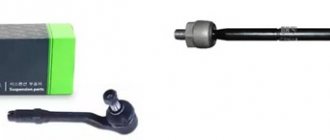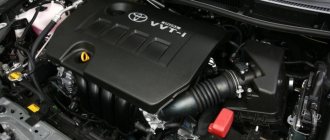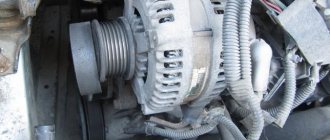Hi all. In this article I will share with novice collective farmers a method for diagnosing the VVTI system using a Postalovsky oscilloscope. As you know, most modern cars use phase change systems. The presence of this system ensures the removal of more power (up to 30%) from the engine at various loads. However, during operation these systems often fail. This is primarily due to the resource when the system elements wear out and, of course, to the operating conditions. For example, if a car owner rarely changes the oil, the filter mesh becomes clogged, the VVTI valve gets stuck, and deposits accumulate in the clutch itself. These facts lead to system failure and, accordingly, to interruptions in engine operation. Symptoms of a faulty VVTI system are as follows: loss of power, jerking during acceleration, unstable operation of the internal combustion engine. And now, friends, let’s imagine that your engine suddenly becomes depressed and you are tasked with determining the cause of the malfunction. It is clear that with such symptoms (loss of power, jerking during acceleration, unstable operation of the internal combustion engine), various engine components come under suspicion and, first of all, the fuel system. In addition, ignition coils are not excluded. Or maybe compression? Here, in order not to guess on coffee grounds and severed chicken heads, it will be very useful to conduct a general analysis of the operation of the internal combustion engine using a Postalovsky oscilloscope. There are kamarads in nature, such a wonderful device as the Postalovsky oscilloscope, which records signals from the engine. One wonderful Ukrainian programmer wrote a program (script) that, based on the data received, measures the operating efficiency of each cylinder of your engine. The name of this respected man is Andrey Shulgin. Postalovsky's oscilloscope has analogues, for example Diamag, etc., but the script itself has a common name - CSS. Shulgin wrote several more scripts, but we’ll talk about them later. How the device works and what the CSS script does... Essentially, everything is simple. The device is connected to the engine and signals are recorded from the crankshaft sensor, the ignition coil, usually the first cylinder, and in our case, additionally, to diagnose the VVTI system, we will record the signal from the camshaft sensor. These signals look like the figure below.
To prepare the data, we need to perform a number of manipulations with the engine running according to standard methods. Namely, start recording from idle, then smoothly (within 3-4 seconds) raise the speed to 4-5 thousand and release the gas pedal. Next, let the idle speed settle and sharply press the gas. as soon as the rpm reaches 3500, turn off the ignition and do not release it, but hold the gas pedal so that when the engine stalls, the throttle remains open. We stop the recording and then the magic of the script begins. The program calculates the data and gives us the result of the operating efficiency of each individual cylinder at various speeds. Moreover, the graph of the operating efficiency of each cylinder has its own color. In essence, we get a kind of cardiogram of the heart of your car (engine), which shows its current state and how it works. Based on this “cardiogram,” you can understand how the injectors work, how the ignition system works (are there any interruptions in the operation of the spark plugs or coils), and you can even roughly assess the state of compression in the cylinders. But. On our collective farm, we have recently slightly changed the standard methodology for carrying out the CSS script and added to it several throttle shifts with the automatic transmission engaged. This was done in order to see how the cylinders work under load, since many malfunctions appear precisely under load. As a result, if we have a CORRECT car, then we get approximately the following data.
Background - read HERE Friends, I think I got to the bottom of the truth...
Previously, I had read tens of thousands of pages of forums dedicated to “rumble”. Topics on this “topic”: DARKNESS (sorry for the taftology)
The solution to this problem comes down to the following:
I will list several methods
1) Tension the generator belt.
In later versions of 1NZ, a kind of “parasitic roller” appeared, its essence is to tension the alternator belt at high speeds. Old or insufficiently tensioned belt = rumbling (chattering) at 2000 rpm. Taken from HERE - allion herders forum (I almost wrote reindeer herders =)))
In general, in order to exclude any attachments: compressor, generator, power steering or pump, I first recommend taking off all the attachment belts and starting the warm engine for a minute. Perhaps an unpleasant sound is produced by some component due to a worn bearing.
2) The same method for 1ZZ (2ZZ and ZeZesh Europeans)
Let's watch the video.
3) Problem with one of the VVT-i systems.
There are many reasons for this. I'll start small - Cleaning the VVT-i mesh.
I already wrote how to do this - HERE
In general, solving problems with the VVT-i system can be divided into 3 parts
a) cleaning the mesh is the simplest thing (see link above) b) replacing the valve is the second thing worth checking c) replacing the coupling is the last thing you need to do, but most likely in 90% of cases IT is the one to blame
So we’ve sorted out the mesh, let’s look at the VVT-i valve.
I recommend checking the serviceability of the VVT-i valve in the following way. To do this, with the engine off, press the valve briefly
apply 12 volts (polarity is not important, hold for no more than 2 seconds). The valve should click.
There is one pitfall here, despite the fact that the valve may click, the rod inside the valve itself may be broken off. The only way to find out for sure is by removing the valve from the engine (who knows, it may have already been removed before you). Do this very carefully and under no circumstances pull on the connector!
The clutch is checked with the engine running by applying power to the valve. should immediately
stall.
Apply power for no more than 2 seconds
, otherwise you will burn the valve winding. If the engine does not stall, then either the valve is dead (although it clicks, this also happens) or the clutch is faulty (jammed in one position or clogged with sludge).
Recommendations
Comments 38
My experience with this problem is as follows. 1) Changed the tensioner of the attachment. Did not help! The rumble at 1450 rpm remains, there is a rattling noise during startup. 2) I drilled holes in the intake manifold in the right places with screws and supposedly screwed on this dangling bar. The situation has not changed. I installed the contract on the manifold, nothing has changed either 3) I changed the Chain, the hydraulic chain tensioner, the damper and tensioner shoes and the VVT-i coupling and the exhaust camshaft sprocket. Everything is Original. Nothing changed. There was only an additional clattering noise when the engine was not fully warmed up. After half an hour of driving, the clattering noise goes away. As if the clutch is cracking. 4) Replaced the VVT-I valve with a new, original one. Nothing changed. I checked the operation of the VVT-i valve, everything is fine, the car stalls. 5) Connecting three scanners did not show any errors. 6) Recapitalized the engine. Boring of cylinders, replacement of all liners. The situation has not changed. 7) We washed the VVT-I valve mesh, the situation did not change. Checked the oil pressure and pressure relief valve in the oil pump. Everything is in excellent condition. The oil pumps as it should, the pressure relief valve works as it should. 9) The pan and oil receiver were, of course, washed during capitalization. Nothing changed. 10) The valve clearances were checked and they were shuffled into the capital. Nothing changed. 11) The spark plugs were changed, the injectors were put under contract, nothing has changed. 12) Flushing the throttle and idle air valve did not give anything. Replacing the throttle didn't do anything either. 13) The generator has been restored. They replaced everything that was possible on it.
1) Changed the tensioner of the attachment. Did not help! The rumble at 1450 rpm remains, there is a rattling noise during startup. 2) I drilled holes in the intake manifold in the right places with screws and supposedly screwed on this dangling bar. The situation has not changed. I installed the contract on the manifold, nothing has changed either 3) I changed the Chain, the hydraulic chain tensioner, the damper and tensioner shoes and the VVT-i coupling and the exhaust camshaft sprocket. Everything is Original. Nothing changed. There was only an additional clattering noise when the engine was not fully warmed up. After half an hour of driving, the clattering noise goes away. As if the clutch is cracking. 4) Replaced the VVT-I valve with a new, original one. Nothing changed. I checked the operation of the VVT-i valve, everything is fine, the car stalls. 5) Connecting three scanners did not show any errors. 6) Recapitalized the engine. Boring of cylinders, replacement of all liners. The situation has not changed. 7) We washed the VVT-I valve mesh, the situation did not change. Checked the oil pressure and pressure relief valve in the oil pump. Everything is in excellent condition. The oil pumps as it should, the pressure relief valve works as it should. 9) The pan and oil receiver were, of course, washed during capitalization. Nothing changed. 10) The valve clearances were checked and they were shuffled into the capital. Nothing changed. 11) The spark plugs were changed, the injectors were put under contract, nothing has changed. 12) Flushing the throttle and idle air valve did not give anything. Replacing the throttle didn't do anything either. 13) The generator has been restored. They replaced everything that was possible on it.
What am I doing wrong to solve the problem? I no longer see the point in putting in a contract, since about 60 thousand rubles have been invested in the engine. Almost everything in the engine has been replaced.
Before the capital, there was a problem with a rumble at speed and rattling during hot starting. + Also, when going up a hill, the engine makes an unpleasant sound, as if it is choking. After the engine was overhauled, all these problems were supplemented by a metallic clatter (the ratchet seemed to be out of lock and could not return) on a not fully warmed-up engine. Then it disappears over time when driving and can also accidentally return. The remaining symptoms are identical. Rumble at 1450 rpm, chain rattling when starting up hot and a wild decrease in traction, as if someone was holding it by the ass.
Damn, I don't even know. You seem to have gone through fire, water and copper pipes. I came to the conclusion that the rumble can be caused by the load at idle using steel test. One should take a stethoscope, the other sits in the car and accelerates, simultaneously pressing the gas and brake (but this must be done for a short time!) I think that your clutch is squealing or it was installed incorrectly or the pin in it is worn out. Another variant of the rumble: one of the airbags is tired, the engine sags under load and the exhaust begins to touch the protective clamp.
The pillows are all new and the original ones were installed. There was no rumble immediately after the capital. It has only now begun to appear, 3000 miles after the capitalization. As for the coupling, I have a suspicion that it was somehow installed incorrectly or that it is defective.
Disadvantages of the 1ZZ-FE engine
- Engine with repair problem;
- Increased oil consumption.
Disadvantages of the 1ZZ-FE engine in detail...
Engine with repair problem
As soon as anything happens to the piston and rings, official dealers will replace the block on vehicles under warranty. This is because the motor design is designed to last without major repairs. There are no major overhauls in the engine life cycle. That is, the sleeves are not bored. For this reason, you don’t have to ask official engine dealers for parts with repair dimensions. I did not say that repair is impossible; repair can be done by replacing it with new parts and assembly units. For example, the crankshaft assembly, cylinder block with pistons assembly, which are sized according to the drawings for newly manufactured engines.
Increased oil consumption
The disadvantage is caused by the design feature of the engine and the quality of domestic gasoline. The reason for the increased consumption is the obstruction of the oil scraper rings and the dilution of the oil in the crankcase with gasoline.
Choosing a car is never easy. Don’t rush into buying a car, first study the tactical and technical characteristics of the engine, its features, disadvantages and weaknesses. The first step is to take into account the spent part of the engine's life. For the 1ZZ-FE engine, the built-in resource for trouble-free operation of the engine is approximately 200 thousand km, after which the timing chain and rings are replaced with new ones (according to reviews), after which the engine runs smoothly up to 500 thousand km.
PS Dear owners of Toyotas with the 1ZZ-FE engine! I ask you to write about your practical conclusions when operating machines with this engine.
How the system works
The operating principle of the VVT-I system promotes a smooth change in valve timing, depending on the operating conditions of the power unit. This occurs due to the rotation of the intake camshaft in relation to the drive gear in the range from 40 to 60 degrees.
The VVT drive, equipped with a vane rotor, is mounted on the intake shaft. If the engine is at rest, then normal starting is ensured by a special clamp that holds the camshaft in the maximum delay position.
Due to the electromagnetic valve controlled by the electronic unit, the oil supply in the delay and advance cavities of the VVT drive is adjusted. Information on the dosage of supplied oil is taken from the signals of the camshaft position sensor. The maximum delay angle when the engine is off is created thanks to the spool, which is moved by a special spring.
Commands to the solenoid valve come from the engine control unit. Depending on the specific motor mode, the following may occur:
- the valve goes into advanced mode and moves the spool of the control mechanism. In this case, the oil flow is directed to the rotor from the side of the advance cavity, turning the camshaft;
Incorrect operation of VVT-I
VVT-I problems may be accompanied by the following symptoms:
- periodic manifestation of unstable engine operation, which is accompanied by a prolonged increase in speed. The problem lies in the wedging rod;
- When the transmission is engaged in neutral, the engine speed increases sharply to a value of 3000 to 4000 rpm. In this case, error No. 59 appears. This is the only sign of a malfunction of the VVT-I sensor, which is accompanied by an error;
- increase in fuel consumption. Provided that elements such as spark plugs, throttle assembly, lambda sensor and so on are checked;
- loss of traction of the power unit when operating at low speeds;
- manifestation of floating speed when the gear is engaged, when in traffic jams. You will first need to check other components of the fuel system;
- when starting from a standstill, there is a sharp increase in the speed of the power unit, followed by a decrease to zero. As a result, the engine stalls;
- an uneven set of revolutions when accelerating a car, accompanied by sharp jerks.
The listed problems may arise due to failure of the following VVT-I elements:
- valve – damage is caused by the use of poor quality oil or mechanical wear;
- the clutch is also picky about the quality of the oil used. The malfunction is accompanied by an extraneous knock. The element itself may have a collapsible or non-collapsible design. In most cases, when installing a collapsible coupling, it is enough to replace the rubber gasket;
- temperature sensor - the correct functioning of the system directly depends on the temperature of the power unit. If the sensor breaks down, problems with VVT-I operation occur.
Misconceptions
The operation of the VVT-I system raises many questions that give rise to various misconceptions. Among them are:
- VVT-I operates exclusively at high speeds, so idle speed problems are not related to it in any way. In fact, the system is involved in the operation of the engine at idle speed. At high speeds, valve opening should be observed, and at idle, the camshaft rotation angle becomes maximum. If there is a malfunction in the mechanism rod, the specified angle is violated, which is accompanied by floating engine idle speed;
- the engine can safely operate even with a faulty VVT-I valve, without loss of power. This opinion is considered not entirely correct. If the regulator is turned off, the motor will indeed operate practically unchanged. But if the device is connected and faulty, problems will occur in the functioning of the power unit.
- Checking the VVT-I valve on the 1ZZ-FE engine is carried out using the following method: turn off the supply loop; the engine starts; 12 V power is supplied to the sensor. If the operations performed lead to the power unit stopping, then VVT-I is working. In practice, this technique only works when the valve is obviously faulty. If wedging is observed, the result may be contradictory.
- The faulty part can be inspected. This statement is considered erroneous. This is due to the fact that there are both collapsible and non-dismountable devices. The most that can be done is to clean the valve. It is almost impossible to adjust spring compression according to factory requirements;
- You can save money by purchasing a VVT-I sensor from disassembly. This option can of course be used, but the risk of acquiring a worn valve is very high;
- A cheap analog sensor works no worse than the original. Here everything depends on the quality of the analogue; as a rule, when installing it, weak traction of the power unit is observed at low speeds.
In order to be sure that the VVT-I valve is faulty, you will need to try installing a known-good sensor and test the performance of the motor.
Cleaning
In order to check the cleanliness of the valve on the 1ZZ-FE engine, you must do the following:
- One VVT-I valve is mounted on the 1ZZ power unit. It is secured with a single bolt. Therefore, to remove it, it is enough to unscrew the indicated bolt. You will need to remove the sensor extremely carefully so as not to damage it;
- An oil filter is located directly below the part, through which oil is supplied to the clutch. It is also secured with one bolt. It is better to remove the filter to check its condition;
- in the future, you will need to flush the VVT-I valve and check its functionality by briefly applying a voltage of 12 V. The supply of power to the sensor is accompanied by retraction of the rod; when the voltage is removed, the rod disappears. You will need to pay attention to the freedom of movement of the rod. If he walks easily, then the sensor is working.
Repair
The following factors may cause repair of the VVT-I valve:
- a break in the coil, which is accompanied by the absence of any reaction when voltage is applied to the sensor;
- Mechanical jamming of the rod is observed due to dirt getting into the internal cavity of the device or wear of the internal rubber gasket.
Before carrying out repair work, you will need to purchase the appropriate repair kit. Repairs can only be made if the sensor has a dismountable design. For the 1ZZ Toyota engine, the lubrication system valve 15330-22030 is used. Next, remove the VVT-I sensor, the dismantling process is described in the previous paragraph, and proceed to the following steps:
- We apply marks to fix the location of the rod. This will be needed to eliminate errors during reassembly;
- We proceed to disassemble the valve from both sides. To do this you will need to flare it using a screwdriver. This will allow you to check the condition of the coil and rod of the device;
- the rod is dismantled and the condition of the rubber gasket is checked. If it is in unsatisfactory condition, then we replace it;
- Subsequently, the condition of the spring and oil seal is monitored and, if necessary, they are replaced;
- the elements of the disassembled VVT-I valve are thoroughly washed. Next, assembly is performed in reverse order.
Weaknesses of the 1ZZ-FE engine
- Cylinder block;
- Cylinder head.
Weaknesses of the 1ZZ-FE engine in detail...
Cylinder block
To reduce costs and facilitate production, the cylinder block has an open cooling jacket; accordingly, this has led to a decrease in the rigidity of its structure.
Cylinder-piston group
In engine , due to the reduction in the diameter and length of the crankshaft journals, their load and wear increased. The oil must be changed early, otherwise coking of the piston rings is inevitable. The rings are T-shaped, which may be why they start knocking earlier.
Cylinder head
You can forget about replacing seats and valves due to the disposable head design. It is also impossible to adjust the thermal clearances in the valves, except at authorized dealers. Adjusting the valves is only possible by accurately selecting the dimensions of the pushers to ensure clearance. Most car owners, when problems with the head are identified, instead of adjusting the valves at the dealer, sell their car.










